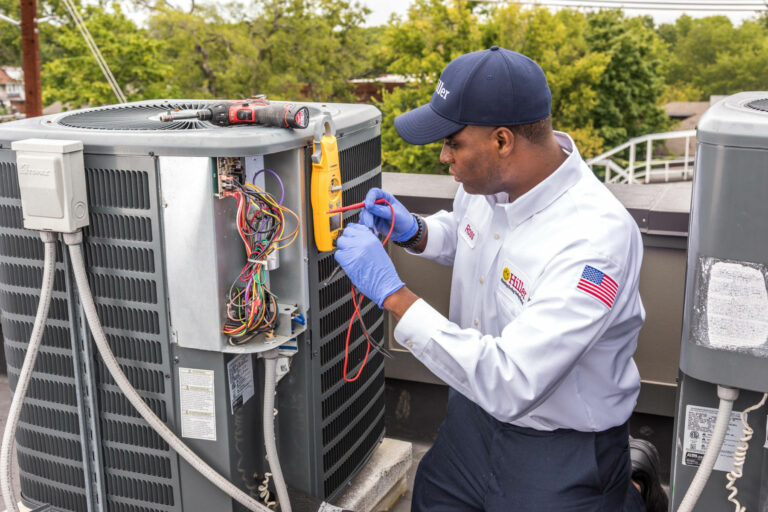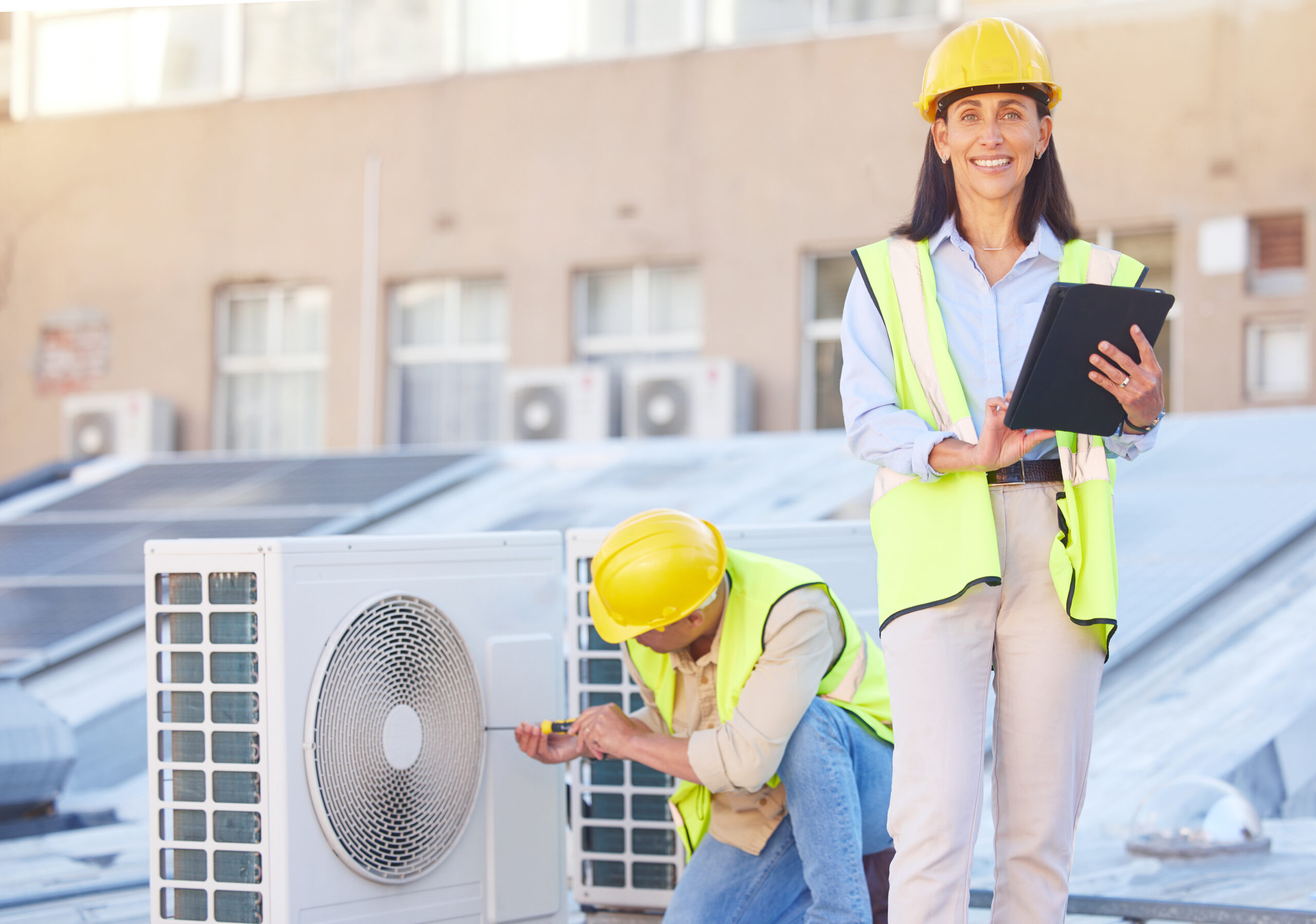How a Heatpump and Heater Interact to Enhance Your Home's Heating Effectiveness
Comprehending exactly how a heatpump and furnace job with each other is necessary for home owners looking for effective heating services. Each system has its toughness, providing a well balanced method to home comfort. The heatpump excels in moderate temperature levels, while the heater provides quick heat throughout extreme cold. This synergy not just decreases power expenses yet also enhances the life expectancy of both appliances. What variables affect this partnership, and exactly how can property owners optimize their advantages?
Recognizing Warm Pumps: How They Work
Many individuals might be unknown with their internal functions, heat pumps play an essential role in contemporary heating systems. These gadgets operate by moving warmth from one location to one more, utilizing the principles of thermodynamics. In cooler months, a warmth pump essences warm from the outdoors air, ground, or water, and transfers it inside your home to heat the home. Conversely, during warmer months, it can turn around the process, working as an air conditioning unit by eliminating warm from inside to the outside.Heat pumps contain an evaporator, compressor, condenser, and growth valve. The cooling agent within the system soaks up warm as it vaporizes at reduced temperatures and pressures. The compressor then increases the pressure and temperature level of the cooling agent, allowing it to launch warmth as it condenses. This reliable procedure can substantially lower power intake contrasted to standard home heating techniques, making warmth pumps a lasting option for climate control in homes.
The Function of Furnaces in Home Heating
Furnaces play a necessary role in home heating by supplying a dependable source of warmth throughout the cooler months. They run by generating warm through combustion or electrical resistance, dispersing it throughout the home via air ducts or glowing systems. The performance of a heater is frequently measured by its Annual Fuel Usage Effectiveness (AFUE) score, which suggests exactly how efficiently the unit transforms gas into heat.Furnaces can utilize various power resources, including gas, oil, electrical power, or gas, allowing homeowners to pick the most ideal choice for their requirements. Unlike heatpump, which may struggle in severe chilly, heating systems keep constant efficiency, ensuring that interior temperatures continue to be comfy despite outdoor problems. Additionally, modern-day heating systems usually come outfitted with sophisticated technology, such as wise thermostats and variable-speed blowers, boosting their efficiency and responsiveness. This convenience makes furnaces a crucial element in comprehensive home heating techniques.

Benefits of Utilizing Both Systems With Each Other
Combining the strengths of both heaters and heat pumps can cause a much more efficient and effective home heating option. Using both systems allows property owners to take advantage of the heatpump's power effectiveness during milder temperature levels while depending on the furnace for more extreme cold problems. This twin approach can substantially decrease energy costs, as heat pumps take in much less electrical power than traditional heating techniques when temperatures are moderate.Additionally, using both systems with each other can improve convenience degrees in the home. Heat pumps can provide regular, also heating, while heating systems can quickly elevate ambient temperature levels when required. The combination of both systems can extend the life-span of devices by lowering wear and tear on each system, as they share the work. Eventually, property owners can appreciate a well balanced, affordable home heating solution that changes effortlessly to varying weather, guaranteeing a cozy and inviting home throughout the cold weather.
Just How Warm Pumps and Furnaces Enhance Each Other
They produce a complementary heating system that optimizes performance and comfort when homeowners integrate heat pumps and furnaces. Heatpump operate by transferring heat from the outside air or ground, making them highly reliable in moderate environments. They excel during milder temperature levels, providing affordable heating. Alternatively, heaters generate heat with combustion or electric resistance, providing solid, prompt heat throughout severe chilly conditions.The mix of these 2 systems permits vibrant changes based upon temperature level variations. Throughout warmer months or milder winter months days, the warmth pump can take the lead, preserving power and minimizing costs. As temperature levels drop, the furnace can seamlessly involve, ensuring regular heat throughout the home. This synergy not just enhances energy usage however likewise enhances the life-span of both systems, as each system operates within its ideal efficiency variety. Together, they develop a well balanced atmosphere that adjusts to varying environment demands.
Optimizing Performance: Tips for Homeowners
House owners can enhance their home heating efficiency via a number of sensible techniques. Developing a routine upkeep routine, incorporating wise thermostat technology, and implementing reliable insulation and sealing remedies are crucial actions. These actions not only improve convenience however also minimize energy prices.
Routine Maintenance Schedule
To assure maximum home heating efficiency, establishing a regular upkeep routine is necessary for any type of home. Homeowners ought to prioritize additional info regular inspections of both heatpump and heaters to identify peak efficiency. This includes altering air filters each to 3 months, as clogged filters can considerably minimize performance. Additionally, scheduling expert maintenance at the very least yearly allows service technicians to recognize and address potential problems before they intensify. Home owners should also clean up the heatpump's exterior device to stop debris buildup that can impede air flow. By adhering to a routine upkeep routine, house owners not just boost their heater' performance but likewise prolong their life-span, leading to greater convenience and lowered power prices throughout the cooler months.
Smart Thermostat Assimilation
Integrating a smart thermostat right into a home heater can considerably improve power performance, particularly as it allows for precise control over temperature level setups. These gadgets can find out the house owner's timetable and preferences, instantly changing the temperature to maximize comfort while minimizing power use. For example, they can reduce home heating during times when the home is unoccupied, lowering unnecessary intake. Several smart thermostats additionally supply real-time energy usage information, allowing property owners to make enlightened decisions concerning their heating behaviors. Additionally, remote accessibility via mobile phone applications allows individuals to readjust settings from anywhere, making sure the home is warm upon return. Generally, clever thermostat combination not just improves convenience but considerably adds to power savings and performance.
Insulation and Sealing Solutions
Smart thermostats play a vital role in power efficiency, however their performance can be significantly boosted by correct insulation and sealing options. Property owners need to prioritize protecting floors, wall surfaces, and attic rooms to reduce warm loss. Top quality insulation products, such as spray foam or fiberglass, can substantially improve thermal resistance. Furthermore, securing spaces around air ducts, doors, and home windows protects against cold air infiltration and heat getaway. Weatherstripping and caulking work methods for resolving these leakages - heat pump service. Routine assessments for air leakages, together with making use of blower door tests, can help identify trouble locations. By buying insulation and sealing, house owners can enhance the efficiency of their home heating systems, eventually causing minimized power usage and lower energy costs
Typical Myths Concerning Heat Pumps and Furnaces
What mistaken beliefs surround heatpump and furnaces? Several people wrongly believe that heatpump are inadequate in chillier environments. In truth, contemporary heatpump are made to operate efficiently also in low temperature levels, supplying trusted home heating throughout winter months. An additional common misconception is that heating systems are always extra effective than heat pumps. Nonetheless, this depends on the details energy resources and effectiveness rankings of the systems concerned. Some may additionally think that utilizing both systems at the same time is unneeded, but actually, this combination can enhance home heating effectiveness, especially throughout extreme climate conditions. Furthermore, individuals typically think that heatpump need constant maintenance, when in reality, they have comparable maintenance needs to traditional furnace. By disproving these click to read more myths, homeowners can make more educated choices concerning their home heating options, inevitably leading to enhanced comfort and power performance in their homes.
Maintenance Considerations for Combined Solutions

Regularly Asked Questions
Can Warm Pumps Job Effectively in Very Cold Climates?
Heatpump can have a hard time in exceptionally chilly environments as a result of reduced effectiveness and warm removal constraints. However, improvements in modern technology have resulted in designs created for far better efficiency in such conditions, improving their feasibility in harsh environments.
Exactly How Lengthy Do Warmth Pumps and Furnaces Commonly Last?
Heatpump typically last 15 to 20 years, while heaters have a life expectancy of 15 to thirty years. Regular maintenance can expand their durability, making sure effective operation and lowering the demand for early substitutes.

What Is the Average Price of Setting Up Both Equipments?
The average expense of setting up both a heatpump and a furnace normally ranges in between $5,000 to $10,000 - heat pump installation ooltewah tn. Elements affecting this cost consist of system dimension, installation intricacy, and local labor rates
Are There Tax Obligation Motivations for Using Energy-Efficient Home Heating Equipments?
Many house owners ask about tax obligation motivations for energy-efficient heating systems. Different government and state programs usually provide refunds or credit ratings, motivating the adoption of lasting modern technologies to reduce energy usage and promote environmental obligation.
Just how Do I Pick the Right Dimension Warmth Pump and Furnace?
Choosing the best size heatpump and heater involves calculating the home's square video footage, thinking about insulation top quality, and reviewing local climate. Consulting a specialist can assure suitable system efficiency and energy efficiency based upon details requirements. ductless mini splits. Recognizing just how a heat pump and furnace work with each other is essential for homeowners seeking reliable heating remedies. In colder months, a warmth pump extracts warmth from the outdoors air, ground, or water, and transfers it inside to heat the living area. When property owners integrate warmth pumps and heaters, they produce a complementary home heating system that makes the most of efficiency and convenience. Warm pumps run by transferring heat from the outdoors air or ground, making them extremely effective in moderate environments. Heat pumps can battle in very chilly environments due to lowered effectiveness and heat removal limitations
 David Faustino Then & Now!
David Faustino Then & Now! Loni Anderson Then & Now!
Loni Anderson Then & Now! Jeri Ryan Then & Now!
Jeri Ryan Then & Now! Lacey Chabert Then & Now!
Lacey Chabert Then & Now! Peter Billingsley Then & Now!
Peter Billingsley Then & Now!